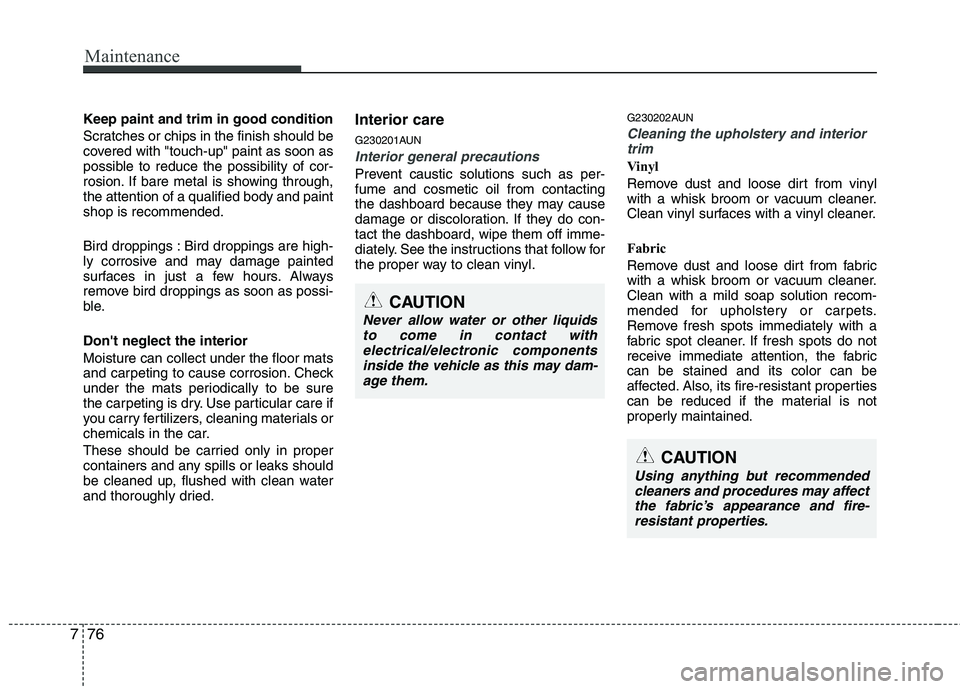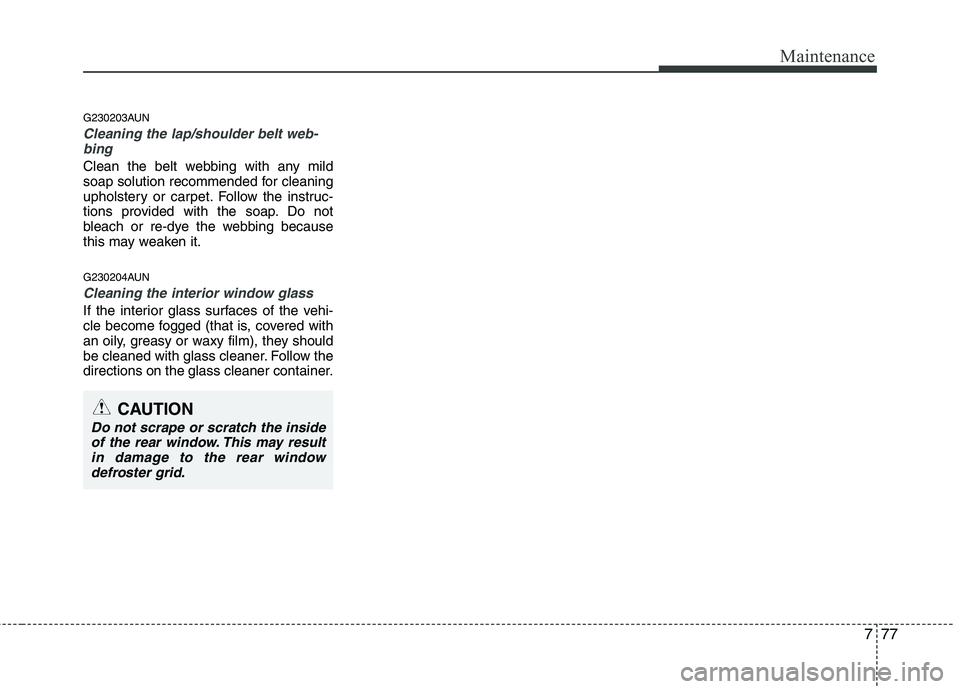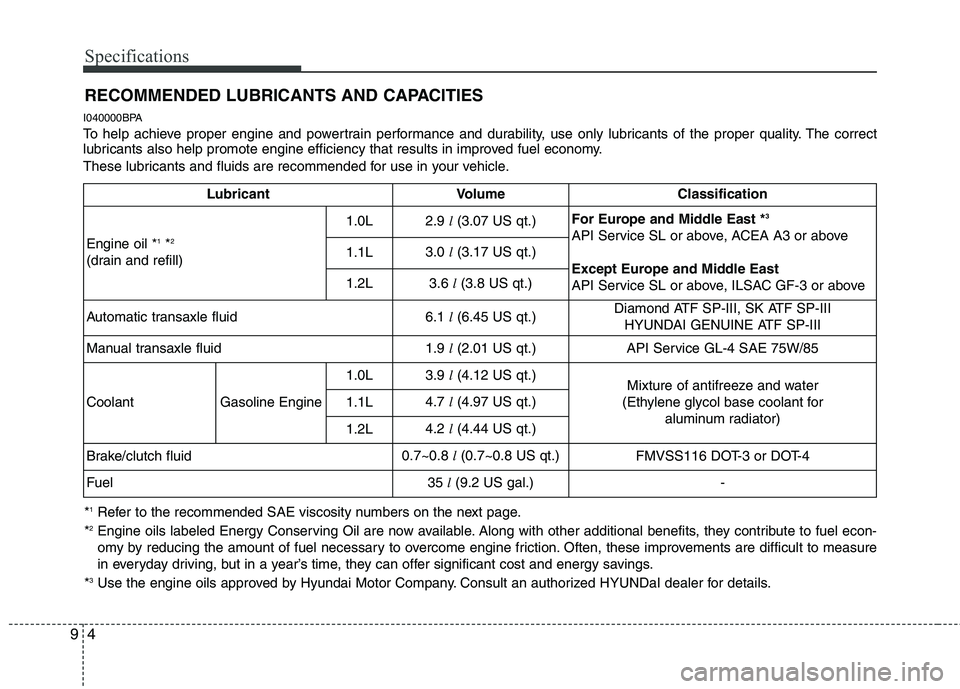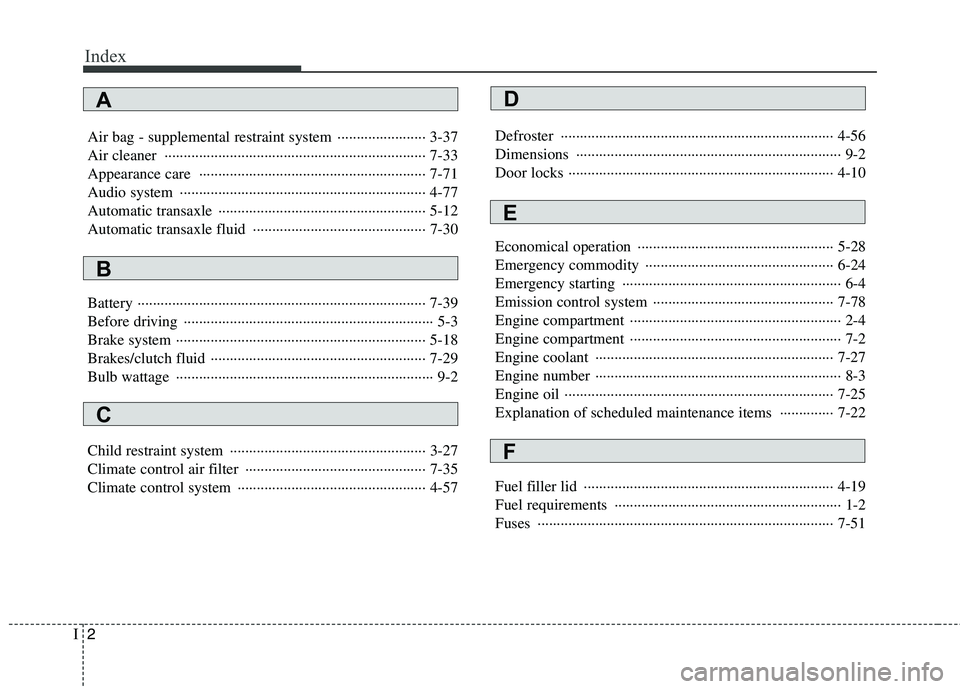2010 HYUNDAI I10 Oil
[x] Cancel search: OilPage 334 of 354

Maintenance
72
7
Waxing
Wax the vehicle when water will no longer bead on the paint.
Always wash and dry the vehicle before
waxing. Use a good quality liquid or
paste wax, and follow the manufacturer’s
instructions. Wax all metal trim to protect
it and to maintain its luster.
Removing oil, tar, and similar materials
with a spot remover will usually strip the
wax from the finish. Be sure to re-wax
these areas even if the rest of the vehicle
does not yet need waxing. G230103AUN
Finish damage repair
Deep scratches or stone chips in the
painted surface must be repaired
promptly. Exposed metal will quickly rust
and may develop into a major repair
expense.
✽✽
NOTICE
If your vehicle is damaged and requires
any metal repair or replacement, be sure
the body shop applies anti-corrosion
materials to the parts repaired or
replaced.
CAUTION
Water washing in the engine com- partment including high pressure
water washing may cause the fail-ure of electrical circuits located in the engine compartment.
Never allow water or other liquids to come in contact with electri-cal/electronic components insidethe vehicle as this may damage them.
OJB037800
CAUTION
Wiping dust or dirt off the body with a dry cloth will scratch the
finish.
Do not use steel wool, abrasive cleaners, or strong detergentscontaining highly alkaline orcaustic agents on chrome-plated
or anodized aluminum parts. Thismay result in damage to the pro-tective coating and cause discol-oration or paint deterioration.
Page 338 of 354

Maintenance
76
7
Keep paint and trim in good condition
Scratches or chips in the finish should be
covered with "touch-up" paint as soon as
possible to reduce the possibility of cor-
rosion. If bare metal is showing through,the attention of a qualified body and paintshop is recommended.
Bird droppings : Bird droppings are high-
ly corrosive and may damage painted
surfaces in just a few hours. Always
remove bird droppings as soon as possi-
ble. Don't neglect the interior Moisture can collect under the floor mats
and carpeting to cause corrosion. Check
under the mats periodically to be sure
the carpeting is dry. Use particular care if
you carry fertilizers, cleaning materials or
chemicals in the car.
These should be carried only in proper
containers and any spills or leaks should
be cleaned up, flushed with clean water
and thoroughly dried. Interior care
G230201AUN
Interior general precautions
Prevent caustic solutions such as per- fume and cosmetic oil from contacting
the dashboard because they may cause
damage or discoloration. If they do con-tact the dashboard, wipe them off imme-
diately. See the instructions that follow for
the proper way to clean vinyl.
G230202AUN
Cleaning the upholstery and interior
trim
Vinyl
Remove dust and loose dirt from vinyl
with a whisk broom or vacuum cleaner.
Clean vinyl surfaces with a vinyl cleaner.
Fabric
Remove dust and loose dirt from fabric
with a whisk broom or vacuum cleaner.Clean with a mild soap solution recom-
mended for upholstery or carpets.
Remove fresh spots immediately with a
fabric spot cleaner. If fresh spots do not
receive immediate attention, the fabriccan be stained and its color can be
affected. Also, its fire-resistant properties
can be reduced if the material is not
properly maintained.
CAUTION
Never allow water or other liquidsto come in contact with
electrical/electronic componentsinside the vehicle as this may dam-age them.
CAUTION
Using anything but recommendedcleaners and procedures may affect
the fabric’s appearance and fire- resistant properties.
Page 339 of 354

777
Maintenance
G230203AUN
Cleaning the lap/shoulder belt web-bing
Clean the belt webbing with any mild
soap solution recommended for cleaning
upholstery or carpet. Follow the instruc-
tions provided with the soap. Do not
bleach or re-dye the webbing because
this may weaken it.
G230204AUN
Cleaning the interior window glass
If the interior glass surfaces of the vehi-
cle become fogged (that is, covered with
an oily, greasy or waxy film), they should
be cleaned with glass cleaner. Follow the
directions on the glass cleaner container.
CAUTION
Do not scrape or scratch the inside
of the rear window. This may resultin damage to the rear window defroster grid.
Page 349 of 354

Specifications
4
9
RECOMMENDED LUBRICANTS AND CAPACITIES
I040000BPA
To help achieve proper engine and powertrain performance and durability, use only lubricants of the proper quality. The correct
lubricants also help promote engine efficiency that results in improved fuel economy.
These lubricants and fluids are recommended for use in your vehicle.
* 1
Refer to the recommended SAE viscosity numbers on the next page.
* 2
Engine oils labeled Energy Conserving Oil are now available. Along with other additional benefits, they contribute to fuel econ-
omy by reducing the amount of fuel necessary to overcome engine friction. Often, these improvements are difficult to measure
in everyday driving, but in a year’s time, they can offer significant cost and energy savings.
* 3
Use the engine oils approved by Hyundai Motor Company. Consult an authorized HYUNDaI dealer for details. Lubricant Volume Classification
Engine oil *
1
*2
(drain and refill)
1.0L2.9 l(3.07 US qt.)For Europe and Middle East * 3
API Service SL or above, ACEA A3 or above
Except Europe and Middle East
API Service SL or above, ILSAC GF-3 or above
1.1L
3.0
l(3.17 US qt.)
1.2L 3.6
l(3.8 US qt.)
Automatic transaxle fluid 6.1
l(6.45 US qt.) Diamond ATF SP-III, SK ATF SP-III
HYUNDAI GENUINE ATF SP-III
Manual transaxle fluid 1.9
l(2.01 US qt.)
API Service GL-4 SAE 75W/85
Coolant Gasoline Engine
1.0L3.9 l(4.12 US qt.)Mixture of antifreeze and water
(Ethylene glycol base coolant for aluminum radiator)
1.1L
4.7
l(4.97 US qt.)
1.2L 4.2
l(4.44 US qt.)
Brake/clutch fluid 0.7~0.8
l(0.7~0.8 US qt.)
FMVSS116 DOT-3 or DOT-4
Fuel 35
l(9.2 US gal.)
-
Page 350 of 354

95
Specifications
I040100BUN Recommended SAE viscosity
number Engine oil viscosity (thickness) has an
effect on fuel economy and cold weather
operating (engine start and engine oil
flowability). Lower viscosity engine oils
can provide better fuel economy and cold
weather performance, however, higher
viscosity engine oils are required for sat-
isfactory lubrication in hot weather. Using
oils of any viscosity other than those rec-ommended could result in engine dam-
age.When choosing an oil, consider the
range of temperature your vehicle will be
operated in before the next oil change.Proceed to select the recommended oil
viscosity from the chart.
CAUTION
Always be sure to clean the area
around any filler plug, drain plug, or
dipstick before checking or drain-ing any lubricant. This is especiallyimportant in dusty or sandy areas
and when the vehicle is used on unpaved roads. Cleaning the plugand dipstick areas will prevent dirt and grit from entering the engine and other mechanisms that could
be damaged.
Temperature Range for SAE Viscosity Numbers
Temperature
For Europe and
Middle East * 1
°C
(°F)-30 -20 -10 0 10 20 30 40 50 -10 0 20 40 60 80 100 120
*1. For better fuel economy, it is recommended to use the engine oil of a viscosity grade SAE0W-40, 5W-30, 5W-40 (API Service SL or above, ACEA A3 or above).
*2. For better fuel economy, it is recommended to use the engine oil of a viscosity grade SAE 5W-20,5W-30 (API SL or above/ILSAC GF-3 or above). However, if the engine oil is not avail-
able in your country, select the proper engine oil using the engine oil viscosity chart.
0W-40, 5W-30, 5W-40
Except Europe and
Middle East * 2
20W-50
10W-30
15W-40
5W-20, 5W-30
Page 352 of 354

Index
2
I
Air bag - supplemental restraint system ······················· 3-37
Air cleaner ···································································· 7-33
Appearance care ··························································· 7-71
Audio system ································································ 4-77
Automatic transaxle ······················································ 5-12
Automatic transaxle fluid ············································· 7-30
Battery ··········································································· 7-39
Before driving ································································· 5-3
Brake system ································································· 5-18
Brakes/clutch fluid ························································ 7-29
Bulb wattage ··································································· 9-2
Child restraint system ··················································· 3-27
Climate control air filter ··············································· 7-35
Climate control system ················································· 4-57 Defroster ······································································· 4-56
Dimensions ····································································· 9-2
Door locks ····································································· 4-10
Economical operation ··················································· 5-28
Emergency commodity ················································· 6-24
Emergency starting ························································· 6-4
Emission control system ··············································· 7-78
Engine compartment ······················································· 2-4
Engine compartment ······················································· 7-2
Engine coolant ······························································ 7-27
Engine number ································································ 8-3
Engine oil ······································································ 7-25
Explanation of scheduled maintenance items ·············· 7-22
Fuel filler lid ································································· 4-19
Fuel requirements ··························································· 1-2
Fuses ············································································· 7-51
A
B
C
D
E
F